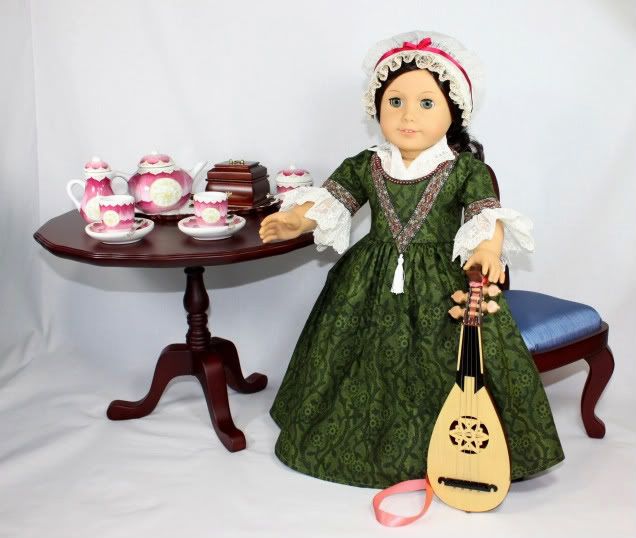Hola! I'm attempting to keep this on target, but I am still slow...
Here is Day Four! Long post ahead!
Here is Day Four! Long post ahead!
Today we have Mary wearing a green dress from Ebay seller I Dream of Jeanne Marie. We've tried to win a variety of her auctions, but we usually don't win. :-( So we were lucky with this one. It came with the mob cap you saw on Angelina with her green dress, a lace fichu, and a very nice copper lantern that you will see in a couple of days here during Colonial Week.
Below Mary is wearing the lace cap from Felicity's red Gala Gown and the fichu that came with the dress. We really love the dark green patterned fabric of this dress with the ribbon and tassel accent on the bodice, as well as the lace on the sleeves. We added in a string of red pearls to complete Mary's "look." And you can see that she is posing with Felicity's guitar.
During the colonial period the guitar was one of the few instruments that women were allowed to play. People thought it looked unflattering for a girl or woman to play the violin while craning her neck or to blow into an instrument like a French horn while puckering her lips. So today we are lucky that girls can play whichever musical instrument they want to. Think of that the next time you dread practicing your music. ;-)
For the rest of this post we are talking more about colonial fashion. We begin with a slideshow of paintings of colonial women in interesting dresses. Most of the portraits are by John Singleton Copley, who was known for his skill in painting fabric in a realistic manner. The paintings show us that a variety of very high-end dresses were worn during portrait sessions. Sometimes a dress was owned by the artist and used as a studio costume, and then we see it in more than one painting.
Can you spot the dresses that appear more than once???
So if we think about the very shiny fabrics and elaborate detailing of many of Felicity's and Elizabeth's dresses that Mattel has created recently, they aren't really completely "off." Of course they are not using the silks and satins that would have been used during colonial times, but dresses were sometimes made in very bright colors, were often shiny in a lustrous manner, and were accented with a lot of lace and bows. But a girl or woman would be lucky to own one or two dresses like the kind we see in the portraits. Most of her wardrobe would have been more casual work clothing made from less expensive fabrics.
Of course we have other historical evidence of what women wore in the 1700s besides portraits--- we even have some surviving clothing which we can study. We mined the collections at the Metropolitan Museum of Art's Costume Institute to find some interesting pics for you.
Fashion in the colonies was a push-pull between English and French trends. But by the end of the 1700s the French had definitely won this fashion war and the wealthiest families in the colonies custom-ordered clothing directly from France. These French style dresses were known as robe a la Francaise, and those from England were known as robe a la Anglaise.
These types of dresses usually featured an underskirt that showed in the front and a long, skirted jacket that wrapped around it. The robe a la Anglaise had a fitted back, like those dresses worn in England. The robe a la Francaise had a looser, pleated back that dropped from the shoulders and was known as a sacque dress back, or sack dress.
Here are some Anglaise dresses...
And here are some Francaise dresses... you can tell which was more popular just by the sheer number that survives for us today... note the photos of the backs of dresses, there you can see the main difference between French and English styles.
As most of you probably already know, Felicity and Elizabeth's dolls were not really made for play. They are fashion dolls that were owned by fabric and dress shops at this point in time. They would be used to display miniature versions of dresses that ladies could order. In our slideshow below you see a real fashion doll that is owned by Colonial Williamsburg's living museum and the two AG fashion dolls.
In our next Colonial Week post (Day Five!) we will talk more about the details of colonial clothing, including the other pieces of attire ladies wore at this time: panniers, stomachers, corsets, etc. to help round out your colonial fashion knowledge. Stay tuned for more colonial fun and more handmade clothing!


3 comments:
Wow!! So much knowledge. Nora, you should receive extra credit at school in history for your work on colonial week. Thanks for all your hard work.
That's really interesting about the English vs. French styles. I keep wanting to get this pattern
http://www.infinitefreedom.com/susan-payne-pages/05-18-century-watteau.html
and make a Marie Antoinette dress for Halloween. (Do you know where I can find a mini guillotine?)
I am loving this historical fashion week. I hope that you do a 1950s week soon. I have a 50s girl, Suzie Taylor (MyAG #21 with the cat eye glasses from the Sock Hopper outfit) and she only has a few things to wear. I have a ton of childrens' patterns from that era - I love sewing for all time periods but in my secret heart I think I love the Fifties the best.
Just a quick note to let you know that I'm really enjoying your Colonial week - the posts have been very interesting.
Oh, and the green gown is gorgeous! :)
CdnAGLover
Post a Comment